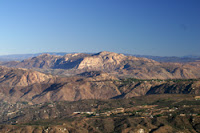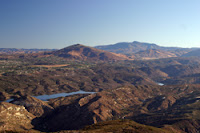
Living in the chapparal means that you're living amongst animals of many kinds: birds, lizards, snakes, mammals, and insects. Most of these animals we cherish, and in fact we go out of our way to attract them to near our home so we can view them — we put out several kinds of seeds, suet, cracked corn, sugar water (for hummingbirds and orioles), and fresh water to lure all the animals.
But some of these animals are ... less desirable ... to have near our home. Mountain lions, though beautiful, are dangerous to our pets and possibly even to us. Rattlesnakes are less dangerous than their reputation, but still not exactly fun to share your yard with. Skunks, well, you know. Coyotes can be a problem, especially with pets. And there's an insect here that strikes fear into many people: the "tarantula hawk" (actually a wasp). But if you were to ask my wife to make a prioritized list of all the beasties she loves to hate, ants would be near the top, I'm sure.
Ants are marvelous little "machines" for finding food. And out here in the dry, near-desert of the chapparal, they've also honed their skills at finding water. Especially in the dry part of the year, they find some way to get into our home — where they're sure to find some sort of ant treat around. Next thing you know, there's a zillion ants crawling all over in a zig-zag track, piling up on whatever they found attractive. Might be a cup with some water in it, or the water left at the bottom of the dishwasher, or one of the pet's food bowls, or some leftovers that we forgot to send down the disposal. Whatever little morsel there is, those darned ants are going to find it. And for this survival skill they have earned Debi's eternal enmity.
But if you can get past the ... inconvenience ... of ants, there are some interesting things to know about them.
For instance, it's pretty obvious that ants, as a group, are very successful. But you may not be aware just how successful they are. If you measure success by the total weight of a group of animals, then scientists will tell you that ants are either #1 or #2 amongst all kinds of animals (if you include termites in with ants). From the proceedings of the National Academy of the Sciences:
Ants are arguably the greatest success story in the history of terrestrial metazoa. On average, ants monopolize 15-20% of the terrestrial animal biomass, and in tropical regions where ants are especially abundant, they monopolize 25% or more. But ants did not always run the world. They do not appear in the fossil record until the mid-Cretaceous, and for more than the first half of their history — a period spanning 60 to 80 million years — ants occupied a relatively modest position in the terrestrial biosphere. To understand the factors, both ecological and historical, that contributed to the rise of the ants, we require a clearer picture of the stepwise evolution of the major ant lineages. Now, Grimaldi and Agosti report in a recent issue of PNAS the remarkable discovery of a worker ant, preserved in amber for over 90 million years, that is clearly assignable to a modern ant subfamily that contains many familiar extant species, including carpenter ants. Combined with other paleontological and phylogenetic information, this unexpected fossil strongly indicates that the diversification of many ant subfamilies occurred earlier and more rapidly than previously suspected.
Ants represent the family Formicidae in the insect order Hymenoptera and, like the yellow jackets, hornets, and paper wasps to which they are closely related, ants are stinging wasps. All ants are eusocial, that is, they live in colonies in which a wingless neuter daughter caste cooperates to raise subsequent generations of their mother queen's offspring. Like all of its descendants, the ancestral ant was almost certainly eusocial, with colonies made up of small bands of hunter-gatherers living in simple temporary nests in the soil. From this modest beginning arose the current diversity of the family Formicidae, numbering over 9,500 described species and an estimated 3,000 to 9,000 additional species as yet unknown to science. Today ants occupy keystone positions in most terrestrial environments, serving as major conduits of energy and organic material. They are, for example, important turners of the soil, matching or exceeding the activity of earthworms in this role. They are among the leading predators of invertebrates in most ecosystems, and in the Neotropics they are the leading herbivores as well, with leaf-cutter ants taking more than 15% of the fresh vegetation (feeding it to a symbiotic fungus, which they in turn eat). Interactions with ants have shaped the evolution of diverse organisms to an astonishing degree. Ants participate in symbioses — some facultative, some obligate — with over 465 plant species in over 52 families, with thousands of arthropod species, and with as-yet-unknown numbers of fungi and microorganisms. Clearly, the study of most ecosystems must include the study of the resident ant species. Because of their complex colony-level behaviors, ants serve as model organisms for the highly visible disciplines of behavioral ecology and sociobiology, particularly in studies focused on the dynamics of kin selection, within-colony conflicts of interest, caste differentiation, and division of labor.
When you consider how many ants it would take to equal the mass of a single human, and then consider that there are something like 6 billion humans — it's a little difficult to even imagine the number of ants it would take to exceed the weight of all humans. But there really are that many ants, and more — depending on whose estimate you want to believe, the ants weigh somewhere between 2 and 8 times as much as humans!
Wikipedia has an excellent article (with good links) on the Earth's biomass, and the Mad Scientist Network has this article about the biomass of ants.
Of special interest to Debi are things that eat ants. Especially if the ant suffers a little in the process. As you might expect for anything that makes up a goodly percentage of the Earth's biomass, lots of animals of various kinds have decided that ants can be tasty. The preceding link goes to Dale Ward's website, which (amongst other things) has lots of good information about ants.



